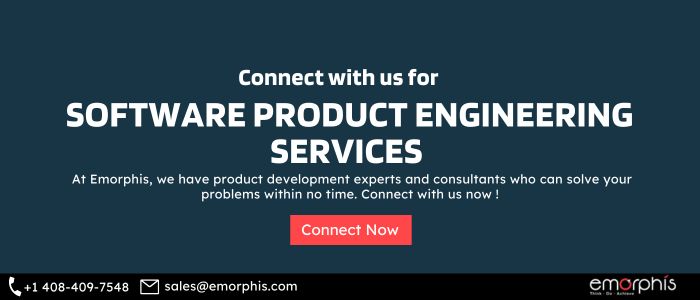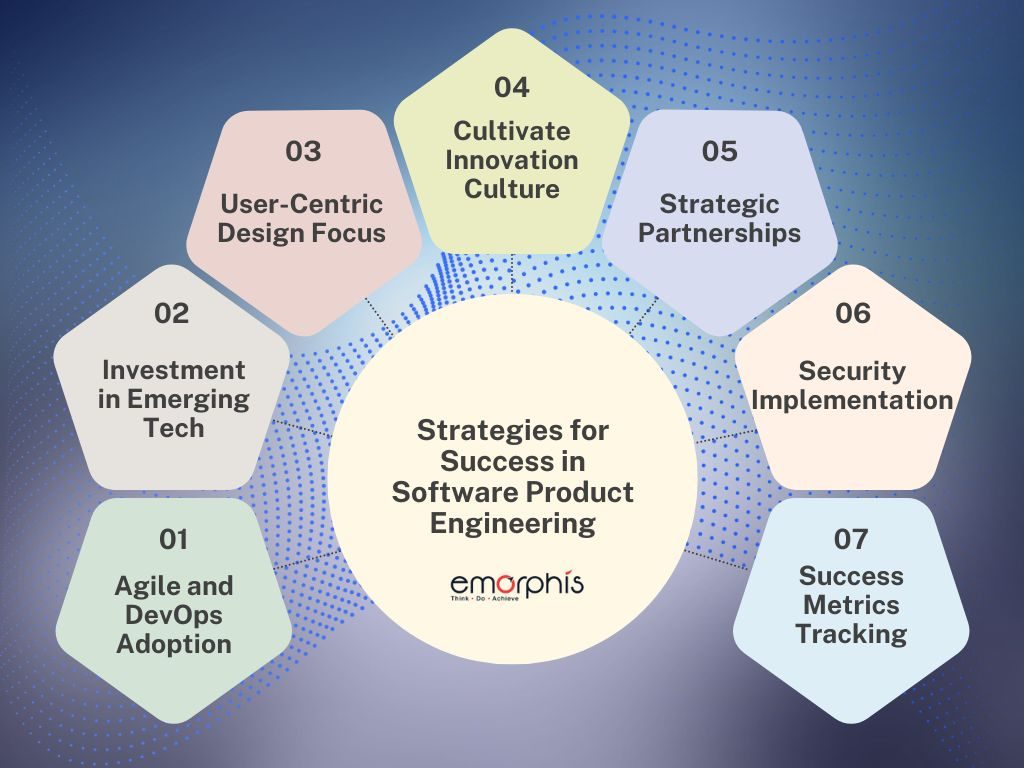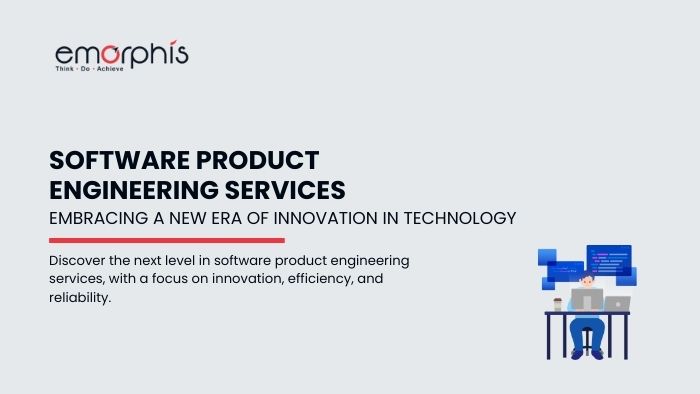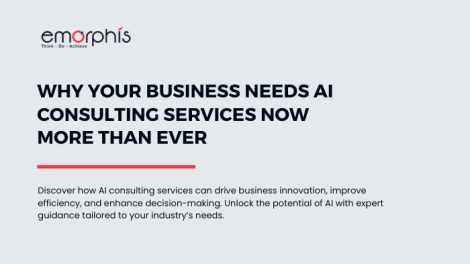Overview
In today's era dominated by technology, adhering to conventional business approaches and policies may not yield the desired success. To achieve your objectives, it's imperative to stay abreast of the latest trends, embrace innovative techniques, and ensure their effective implementation for scaling your business. Software product engineering services stand out as one of the disruptive technologies gaining significant attention recently.
If you're uncertain about the concept of product engineering services and their potential for enhancing business operations and prospects, this guide can provide valuable insights. Let's delve into the intricacies of software product engineering and its benefits in the current dynamic landscape.

Understanding Software Product Engineering Services
Software product engineering represents the future of technology, integrating software and IT solutions with hardware components for the development, testing, and design of innovative products. It offers a competitive edge to businesses engaged in enterprise software development by consistently enhancing product features, quality, lifespan, reliability, and services. These factors are vital for streamlining business operations and remaining competitive in the market.
Understanding software product engineering services illuminates the pivotal role in integrating software and hardware components to enhance product features, quality, and reliability, crucial for bolstering business operations and competitiveness.
Further, explore details on AI in Software Development
Significance of Product Engineering Services for Businesses
For those unfamiliar with the significant advantages of product engineering services, here are some key points to consider:
- Rapid Technological Evolution: Technology evolves rapidly, and businesses must keep pace to avoid falling behind. Product engineering solutions help mitigate risks associated with technological advancements.
- Enhanced Functionality: Product engineering services enable the development of transformative functionalities and features, accelerating business growth.
- Cost and Time Savings: Leveraging product engineering reduces the time and cost required to assemble an experienced software development team, thereby optimizing resource utilization.
- Flexibility and Interoperability: Product engineering offers flexibility and interoperability, facilitating seamless integration with business operations, third-party platforms, and devices.
- Business Strategy Focus: By outsourcing product engineering services, businesses can focus on devising effective business strategies while professionals handle the technical aspects.
Recognizing the significance of product engineering services for businesses lays the foundation for adopting strategies that ensure success in the new era of innovation.
Strategies for Success in the New Era of Innovation
To thrive in this new era of innovation, organizations must embrace the following strategies:
- Embrace Agile and DevOps Practices: Adopting agile methodologies and DevOps principles is essential for accelerating the software development lifecycle, improving collaboration between development and operations teams, and delivering high-quality products to market faster.
- Invest in Emerging Technologies: Stay ahead of the curve by investing in emerging technologies such as AI, IoT, and edge computing. Discover how leveraging these technologies can create innovative solutions that drive business value and differentiate your offerings in the market.

- Focus on User-Centric Design: Prioritize user experience (UX) and design thinking principles to create intuitive, engaging, and accessible software products that resonate with your target audience. Solicit feedback from users early and often to iteratively improve the usability and effectiveness of your products.
- Build a Culture of Innovation: Foster a culture of innovation within your organization by encouraging experimentation, rewarding creativity, and embracing failure as a learning opportunity. Empower employees at all levels to contribute ideas, challenge the status quo, and drive positive change.
- Forge Strategic Partnerships: Collaborate with technology partners, startups, and industry experts to access specialized skills, domain expertise, and cutting-edge solutions. By forging strategic partnerships, you can accelerate innovation, mitigate risks, and unlock new growth opportunities.
- Security Considerations: Implementing robust security measures, including encryption, access controls, and compliance with industry standards, is essential to safeguard sensitive information and protect against cybersecurity threats throughout the development lifecycle.
- Measuring Success Metrics: Defining and tracking key performance indicators (KPIs) such as time-to-market, product quality, and customer satisfaction is crucial for evaluating project success and making informed decisions.
Find the Software Solutions Trends and Innovation
In implementing these strategies, it's important to understand the comprehensive process involved in software product engineering services.
Process of Software Product Engineering Services
Software product engineering services encompass a comprehensive process aimed at designing, developing, and maintaining high-quality software products. Let us check the process now.
1. Requirement Analysis and Planning
- To commence the process, it's crucial to understand client requirements and project objectives thoroughly.
- Following this, we define the project scope, constraints, and success criteria.
- Subsequently, we establish a roadmap and project plan, outlining timelines, milestones, and resource allocation.
2. Design and Architecture
- Once we understand the requirements, the next step is to create a detailed software architecture blueprint.
- This entails defining system components, interfaces, and data flows.
- Furthermore, we craft the design of the user interface (UI) and user experience (UX) to ensure usability and accessibility.
3. Implementation and Development
- Progressing, we develop the software components according to the specified architecture and design.
- To accomplish this, we utilize programming languages, frameworks, and tools best suited to the project requirements.
- Throughout this phase, adherence to coding standards, best practices, and version control are paramount to maintaining code quality and collaboration.
4. Testing and Quality Assurance
- After development completion, we conduct various levels of testing, including unit testing, integration testing, system testing, and acceptance testing.
- We also implement test automation to streamline processes and improve efficiency.
- Furthermore, performance, security, and usability testing are performed to ensure the software meets quality standards.
5. Deployment and Release Management
- As the software nears completion, we prepare for deployment by configuring servers, databases, and infrastructure.
- Throughout this phase, we define deployment procedures and ensure compatibility across different environments.
- Additionally, we meticulously manage software releases, versioning, and rollback strategies to minimize downtime and mitigate risks.
6. Product Launch and User Adoption
- Following successful deployment, coordination with marketing and sales teams is crucial to plan and execute product launch activities.
- At the same time, we provide training, documentation, and support materials to facilitate user adoption.
- Additionally, we gather feedback from early users and iterate upon it to enhance the product's usability and functionality.
7. Maintenance and Support
- After the product launch, we establish processes for ongoing maintenance, bug fixes, and feature enhancements.
- Additionally, we monitor software performance and collect user feedback to identify areas for improvement.
- Finally, we provide timely support and troubleshooting assistance to address issues and ensure customer satisfaction.
8. Continuous Improvement
- To conclude the process, post-implementation reviews are conducted to assess project success and identify lessons learned.
- Continuous improvement is facilitated through feedback loops and agile methodologies to refine development processes.
- Additionally, staying updated with emerging technologies, industry trends, and customer needs drives innovation and maintains competitiveness.
By following this structured process, software product engineering services can deliver robust, scalable, and user-friendly software products that meet the evolving needs of clients and end-users.
Moving from understanding the steps involved in software product engineering services, let's now explore the latest trends shaping its future direction.
Trends Shaping the Future of Software Product Engineering
Several key trends are shaping the future of software product engineering services, including:
- Low-Code/No-Code Development: The rise of low-code/no-code platforms is democratizing software development, allowing business users and citizen developers to create applications without extensive coding knowledge. This trend is accelerating the pace of innovation and empowering organizations to rapidly build and deploy software products.
- Microservices Architecture: Microservices architecture, characterized by the decomposition of applications into smaller, independently deployable services, is gaining popularity for its scalability, flexibility, and resilience. By breaking monolithic applications into smaller components, organizations can iterate faster, scale more efficiently, and respond to changing market demands.
- Containerization and Orchestration: Containerization technologies such as Docker and Kubernetes are revolutionizing the way applications are packaged, deployed, and managed. Containers provide lightweight, isolated environments that streamline the development and deployment process, while orchestration platforms automate the management of containerized applications at scale.
- Edge Computing: Edge computing brings computation and data storage closer to the source of data generation, enabling real-time processing, reduced latency, and improved performance. This trend is particularly relevant for applications that require low latency, such as IoT devices, autonomous vehicles, and augmented reality/virtual reality (AR/VR) applications.
- Serverless Computing: Serverless computing abstracts away infrastructure management tasks, allowing developers to focus on writing code without worrying about provisioning, scaling, or managing servers. This approach offers greater agility, scalability, and cost-efficiency, making it ideal for event-driven and asynchronous workloads.

Conclusion
In conclusion, software product engineering services are at the forefront of innovation in technology. Software product engineering services drive the development of transformative solutions that shape the future of industries. It also empowers organizations to thrive in a digital world. By embracing emerging technologies and adopting agile practices, also, fostering a culture of innovation, organizations can position themselves for success in this new era of technological advancement.
When considering software product engineering services, choosing Emorphis Technologies stands out for several reasons. Firstly, the company has a proven track record of delivering high-quality solutions tailored to clients' needs. Secondly, their team consists of experienced professionals who are dedicated to ensuring customer satisfaction. Additionally, Emorphis emphasizes collaboration and communication throughout the project lifecycle, ensuring transparency and alignment with client goals. Moreover, their commitment to innovation and staying updated with emerging technologies ensures that clients receive cutting-edge solutions.
Overall, by choosing Emorphis Technologies, clients can expect reliable, efficient, and innovative software product engineering services tailored to their specific requirements.
Further, check the details on What’s Next in Software Product Engineering Services?







